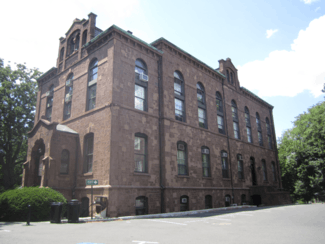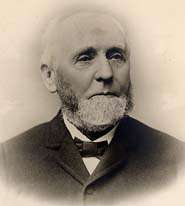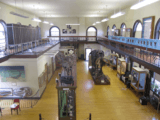Geology Hall
Coordinates: 40°29′55″N 74°26′47″W / 40.498588°N 074.446504°W

Geology Hall, formerly Geological Hall, is a building located in the historic Queens Campus section of Rutgers, The State University of New Jersey's College Avenue Campus in New Brunswick, New Jersey, United States. As part of the Queen's Campus, Geology Hall was included on the New Jersey Register of Historic Places and the National Register of Historic Places in 1973. When Rutgers was selected as New Jersey's only land grant college in 1864, the college began to expand its curriculum to include instruction in science and agriculture. Rutgers president William Henry Campbell raised funds to construct a building to accommodate this expansion, and Geology Hall, designed by architect Henry Janeway Hardenbergh, was built in 1872.
At present, the building houses administrative offices and the university's geological museum. The museum, one of the oldest collegiate geology collections in the United States, was founded by state geologist and Rutgers professor George Hammell Cook in 1872. Its exhibits showcase the natural history of New Jersey; focusing geology, paleontology, and anthropology. Exhibits include fluorescent zinc minerals from Franklin and Ogdensburg, a mastodon from Salem County, a dinosaur trackway discovered in Towaco, and a Ptolemaic era Egyptian mummy.
History
In 1864 the State of New Jersey named Rutgers College as their sole land grant college. Pursuant to the Morrill Act of 1862, this designation gave federal lands to the state that the state could then sell to raise money to develop practical education in agriculture, science, military science and engineering.[1]:pp.87–88[2]

George Hammell Cook (1818-1889), a professor of chemistry and natural sciences, influenced the state to select Rutgers over the College of New Jersey (now Princeton University). Cook was appointed state geologist in 1864 and later became the college's vice president. With the college's land grant status and new funding for scientific studies, Cook expanded his research and teaching into geology and agriculture.[1]:pp.87–88[3][4]:p.27
Six years later, the college's board of trustees decided to erect a building to house the college's new scientific programs.[1]:p.101 At this time, Rutgers was celebrating the centennial anniversary of its second charter (1770) and college president William Henry Campbell (1808–1890) solicited donations from alumni and other supporters in an extensive fundraising effort aimed at supporting these new programs.[3] With these funds, the trustees commissioned a design for a Geological Hall from Henry Janeway Hardenbergh (1847–1918), a young architect from New Brunswick.[1]:p.101[5] Hardenbergh received these contracts through family connections, as several members of his family were graduates, trustees, or associated with the school. His great-great-grandfather, the Rev. Jacob Rutsen Hardenbergh (1736–1790), was Rutgers' first president and one of its founders, and his grandfather, Rev. Jacob Janeway served as vice president of the college and had turned down the post of president in 1840.[5][6]
Hardenbergh's design was described as employing both Gothic elements and classical forms that preceded the extreme eclecticism that was to mark a later Victorian Gothic Revival period.[7] The original plans called for the building to be constructed out of red brick,[7] but the final execution was mostly in sandstone quarried in Connecticut, with some examples of stone from Newark.[8] Geology Hall, built on the south side of Old Queens, was the second of three projects that Hardenberg designed for the college, following an addition to a building (now Alexander Johnston Hall) that housed the college's grammar school (now Rutgers Preparatory School) the year before. The third project, Kirkpatrick Chapel (1873), was designed to complement the simple Gothic Revival style of Geology Hall and was erected on the north side of Old Queens.[5]
The building was completed in 1872 at a cost of US$63,201.54 (2013: US$1,215,365).[3][lower-alpha 1] Geology Hall's first floor provided the college with rooms for laboratory and lecture instruction and housed the college's armory.[1]:p.101 The first-floor classrooms would accommodate the college's physics, military science, and geology departments.[9][10] Geology Hall also provided instruction space for courses in agriculture, chemistry and engineering for several years, until Rutgers built New Jersey Hall (1889) to house the Agricultural Experiment Station, and buildings for the Chemistry and Engineering departments (1909 and 1910 respectively) across Hamilton Street on land that became the college's Voorhees Mall.[1]:pp.148,157 Geology Hall's second floor was designed to provide sufficient space to house the college's natural history artefacts and geological specimens as a museum.[1]:p.101
Today, Geology Hall houses some of the offices of the university's administration and the Rutgers Geology Museum. Previously, it housed the offices of the Rutgers geology department, now called the Department of Earth and Planetary Sciences, from 1872 until 1979, when it moved to the university's Busch Campus in Piscataway. This was the last of the university's science department to move across the Raritan River to the Busch campus.[11] In 1973, Geology Hall was included with six other buildings on Rutgers' Queen's Campus on the New Jersey Register of Historic Places and the National Register of Historic Places.[7][12]
Rutgers Geology Museum
Cook established the university's geology museum in 1872 with specimens collected during the New Jersey Geological Survey which he directed as New Jersey's state geologist.[13] Since then, the museum has operated on the building's second floor, offering free tours to small groups, schools, and to the general public.[13][14] The museum's collections, of which only a small portion is on display, feature exhibits on geology, natural history, paleontology, and anthropology, with an emphasis on the natural history of New Jersey.[14][15]
The museum's earliest collections began to coalesce in 1836 through the work of Lewis C. Beck (1798–1853), a physician, botanist, entomologist, chemist and geologist, who taught at Rutgers in the mid-nineteenth century from 1830 until his death in 1853.[4]:p.37[14] Many of the exhibits feature items that are unique to New Jersey, including Native American artifacts, minerals, and fossils. These exhibits include a set of fossilized dinosaur tracks believed to belong to the carnivorous Grallator, from the Jurassic-period discovered near Towaco in Morris County,[16] and the skeleton of a 10,000-year old mastodon (Mammut americanum) discovered in Salem County in 1869.[15] The mastodon, found in a marl pit near Mannington, was sold by a local farmer to a travelling circus before it was acquired by Rutgers for display.[17][18]
A collection of around 2,400 specimens (including some fluorescent minerals) was donated to the museum in October 1940 by George Rowe, a mine captain with the New Jersey Zinc Company. The collection is rich in rare minerals, many of which found during twentieth-century zinc mining operations in Franklin, New Jersey.[19] This museum's holdings were augmented with the donation of 6,000 fluorescent mineral specimens collected by Anne and Milton Hershhorn.[14] This exhibit opened to the public in October 2002.[20]
The museum displays a 2,400-year-old female Egyptian mummy on loan from the New Brunswick Theological Seminary. The mummy, which dates to 320 or 330 B.C. in the Ptolemaic era, was discovered in Northern Egypt and brought back to the United States by a Dutch Reformed missionary who served there in the early 1700s.[16][21] Little else is known about the mummy's origins, but it was stored in a closet at the seminary until 1968 when it was first put on display.[21]
In 2013, rumors suggested that the university administration was planning to place the museum's exhibits in permanent storage, close the museum and renovate Geology Hall for use as an auditorium.[15] A letter-writing campaign from alumni and the general public persuaded the administration to commit towards continuing the museum and expanding its mission.[22][23]
Gallery
|
References
Explanatory notes
- ↑ This inflation adjustment calculation projects that $1 in 1871 and 1872 would have $19.23 in purchasing power in 2013 (conversion factor: 0.052), using data compiled by Oregon State University Political Science professor Robert Sahr in "Inflation Conversion Factors for years 1774 to estimated 2023, in dollars of recent years" reflecting final 2012 CPI (2.29594 in dollars of 1982–84). Last update May 15, 2013. Retrieved September 2, 2013.
Citations
- 1 2 3 4 5 6 7 McCormick, Richard P. Rutgers: A Bicentennial History. (New Brunswick, New Jersey: Rutgers University Press, 1966).
- ↑ The Morrill Act of 1862 (P.L. 1862 ch. 130; 12 Stat. 504) was codified as United States Code, Title 7, Chapter 13, Subchapter I, § 304 — "Investment of proceeds of sale of land or scrip". Retrieved September 25, 2013.
- 1 2 3 David Murray (compiler). A Memorial of Rev. William Henry Campbell, D.D., LL.D. Late President of Rutgers College. (New Brunswick, New Jersey: Trustees of Rutgers College, 1894), 45–47.
- 1 2 Rutgers College and Raven, John Howard (Rev.) (compiler). Catalogue of the Officers and Alumni of Rutgers College (originally Queen's College) in New Brunswick, N.J., 1766–1916. (Trenton, New Jersey: State Gazette Publishing Company, 1916).
- 1 2 3 Glovin, Bill. "Castles in the Air" in Rutgers Magazine (Spring 2006), 35–41.
- ↑ Staff. "H. J. Hardenberg, Architect, is Dead" in The New York Times (March 14, 1918). Retrieved September 5, 2013.
- 1 2 3 Barr, Michael C. and Wilkens, Edward. National Register of Historic Places Inventory Nomination Form for Queen's Campus at Rutgers, The State University of New Jersey (1973). Retrieved September 5, 2013.
- ↑ Hawes, George W., et al. for the U.S. Department of the Interior, Census Office. "Report on Building stones of the United States and Statistics of the Quarry Industry for 1880" from Final Report on the Tenth Census, Volume 10. (Washington, DC: Government Printing Office, 1884), 310.
- ↑ Rutgers, The State University of New Jersey – Rutgers University Libraries. "Paths to Historic Rutgers: A Self-Guided Tour" from the Special Collections and University Archives: University Archives. Retrieved September 27, 2013.
- ↑ Robbins, Allen B. History of Physics and Astronomy at Rutgers, The State University of New Jersey in New Brunswick, New Jersey, 1771–2000. (Baltimore, Maryland: Gateway Press, 2001), 56, 76.
- ↑ Olsson, Richard. "History of EPS: A Brief History Of Geology At Rutgers, 1830–1980" at Rutgers School of Arts and Sciences: Department of Earth and Planetary Sciences (official website). Retrieved September 27, 2013.
- ↑ The Queen's Campus (total of 6 buildings and grounds) is listed as SHPO ID# 1881, and NRHP Reference #73001113. See: New Jersey Department of Environmental Protection (NJ DEP) — Historic Preservation Office. New Jersey and National Registers of Historic Places — Middlesex County Archived November 7, 2014, at the Wayback Machine. (Last Updated April 5, 2013), 7. Retrieved September 5, 2013.
- 1 2 Rutgers, The State University of New Jersey — Rutgers Geology Museum. "About the Museum" Archived October 2, 2013, at the Wayback Machine.. Retrieved September 27, 2013.
- 1 2 3 4 Rutgers, The State University of New Jersey — Rutgers Geology Museum. 'Rutgers Geology Museum" and "Schedule the Tour". Retrieved September 27, 2013.
- 1 2 3 Kaado, Jad. "Rutgers Geology Museum May Close After 141 Years: Rumor Has it Museum Will Be Converted to Auditorium" in New Brunswick Today (February 1, 2013).
- 1 2 Rutgers, The State University of New Jersey — Rutgers Geology Museum. "Exhibit Highlights" Archived May 23, 2013, at the Wayback Machine.. Retrieved September 27, 2013.
- ↑ Jepsen, Glenn L. "A New Jersey Mastodon: Mastodons in Museums", (originally published Trenton, New Jersey: New Jersey State Museum, 1960; republished online by getnj.com, 2003).
- ↑ Staff. "An Early New Jersey Visitor" in The New York Times (January 25, 1981).
- ↑ Wilkerson, Albert S. (Rutgers University). "Notes and News: The Rowe Collection," American Mineralogist (1941) 26:507–508.
- ↑ Rutgers, The State University of New Jersey — Rutgers Geology Museum. "Fluorescent Mineral Exhibit". Retrieved September 27, 2013.
- 1 2 Dela Cruz, Chris. "23 Centuries Old Mummy Lays in Geology Hall" in The Daily Targum (October 29, 2005).
- ↑ Szteinbaum, Sabrina. "Rutgers Geology Museum to remain fixture on campus" in The Daily Targum (September 4, 2013). Retrieved September 25, 2013.
- ↑ Pineda, Chelsea. "U. to enhance museum’s mission: Rutgers Geology Museum to face changes specifically in dealing with outreach to K through 12 students" in The Daily Targum (February 13, 2013). Retrieved September 25, 2013.
External links
| Wikimedia Commons has media related to Geology Hall (Rutgers). |
- Rutgers Geology Museum (official website)
- Rutgers, The State University of New Jersey
